 Friday - August 07, 2020
Friday - August 07, 2020
Makes Me Wonder

Gotta wonder where that Arctic warming is coming from, eh?
Russia has several thousand nuclear objects dumped on its Arctic sea floor. Now, the most dangerous will be removed
The country’s nuclear energy company will over the next 8 years lift two submarines and four reactor compartments from the sea bottom of the Barents and Kara Seas.These objects are not environmentally safe, a representative of Rosatom made clear as he this week presented a clean-up plan for the north Russian waters.
In the period between the late 1960s to the late 1980s, about 18 thousand radioactive objects were dumped to sea in the remote northern waters. Most of them represent little environmental risk. But some are increasingly seen as a hazard to Arctic ecosystems.
“Rosatom over the next eight years intend to lift from the bottom of Russian Arctic waters the six objects that are most dangerous with regard to radioactive pollution,” the company spokesperson told news agency TASS.
Two entire subsOn the list of objects are the reactors from submarines “K-11”, “K-19” and “K-140”, as well as spent nuclear fuel from the reactor that served icebreaker “Lenin”.
In addition, two entire submarines will be lifted, the “K-27” from the Kara Sea and “K-159” from the Barents Sea. While the former was deliberately dumped by Soviet authorities in 1982, the latter sunk during a towing operation in 2003.
The “K-27” is located on 33 meter depths east of archipelago Novaya Zemlya. It has by experts been described as a possible radioactive “time-bomb”. The “K-159” is located on 200 meter depths off the coast of the Kola Peninsula.
now all they need is for somebody else to pay for the cleanup
The lifting operation of the hazardous nuclear wastes will not only be technically difficult, but also very expensive.
A recent report made for Rosatom and the European Commission evaluated the costs of lifting the six most dangerous objects to €278 million. That includes bringing them safely to a yard for decommissioning and long-term storage.
The operation with the “K-159” is alone estimated to cost €57,5 millions. The lifting the “K-27”, transporting to a shipyard for decommissioning and long-term storage in Saida Bay, will come at a price of €47,7 millions, the report reads.
International cooperationHardly, Russia’s increasingly cash-strapped treasury will not have €278 millions for the cleanup.
Previously, a number of countries have granted billions to Post-Soviet Russian efforts to cope with nuclear wastes.
The greatest amount Global Warming has been along the Russian Arctic coast. Golly, do you think there could be a connection?
Oh BTW, it’s been an imperative that the K-159 and K-27 be immediately raised from the seabed ... for more than 6 years now. That’s after years of empty promises. The ships have been there for decades.
[ May 2014, MURMANSK ]– It is of critical importance that two sunken derelict Russian nuclear submarines, one of which was scuttled as radioactive trash and the other of which sank in rough weather on its way to decommissioning, be raised from the floor of the Kara Sea, scholars from Moscow’s Kurchatov Institute said Friday.
The two subs in question – the K-159 and the K-27 – lay on the ocean floor, the first at the entrance to Kola Bay and the second in the shallows surrounding the Novaya Zemlya Archipelago, a former nuclear bomb testing range during Soviet times, as well as something of a dumping ground for Cold War legacy nuclear waste.
Both have also been the subject of long-time promises by Russian officials that they will indeed be raised.
According to Alexei Kazennov, a researcher with Moscow’s respected Kurchatov institute, the K-159, which sank in August 2003 under tow to decommissioning at the Nerpa shipyard – in more than 200 meters of water, taking with it 800 kilograms of highly enriched uranium fuel and claiming the lives all nine sailors aboard – is currently emitting one and a half times as much radioactivity as dozens of other radiological hazards dumped at sea over time by the Soviet and Russian navies.
The K-27 submarine, was scuttled in 50 meters of water in Stepovogo Bay of the Novaya Zemlya Archipelago in the Kara Sea in 1981 after a serious reactor accident that killed nine. Its reactors contain 90 kilograms of uranium-235.
...
It is worth bearing in mind that the K-159 sunk while under tow across a major ship-trafficking waterway as well as one populated by fisheries.
...
Large-scale dumping of radioactive waste and nuclear fuel was at its height between 1965 and 1972. Some 17,000 tons of solid radioactive waste are estimated to have been purposely sunk in its waters, in addition to the K-27, and the 907 nuclear submarine, which has two reactors on board. Other solid radioactive waste in the region includes biological shielding assemblies from the Lenin nuclear icebreaker, whose location has not yet been determined. Another piece of unaccounted-for nuclear trash under the sea is the port-side reactor of the 421 nuclear submarine.According to the Kurchatov Institute, the biological shields are the most radioactive of waste items sunk in the Kara Sea, second only to spent nuclear fuel. The activity of a caisson with such a biological screen in 2012 measured 1196.7 terebequerel, or 32.4 kilocurie, which is some 30 percent of the entire activity of radioactive waste submerged in the Kara Sea.
How do you say “We’ll get right on it, someday, maybe” in Russian?
Posted by Drew458
Filed Under: • Environment • Russia •
• Comments (1)
 Wednesday - June 10, 2020
Wednesday - June 10, 2020
The Current Global Disaster That Didn’t Make The News At All
MAJOR PETROLEUM SPILL OF NEARLY 3/4 MILLION GALLONS
The Taymyr Penninsula is in northern central Russia along the Arctic Ocean. It is between 1200 and 1700 miles east of Finland and about 1600 miles west of Alaska. This is one of the more remote and inhospitable places on the planet.
Norilsk is a mining and industrial city in the southwest end of the peninsula. What isn’t mines is boggy swamp, when it isn’t frozen solid by the 8 months long brutal winter.
At the Norilsk-Taymyr Energy Company there, a massive spill of diesel fuel from their giant storage tanks has released more than 21,000 tons of diesel fuel into the local waterways and across the tundra. That’s at least 600,000 gallons.
And there’s no way to clean it up right now. They can try and contain it, but actual removal won’t happen for months until things freeze up again.
Perhaps the leaking tanks are right here: 69.329191, 88.251773 (decimal map ref).
There is not a lot of precise information available, but it doesn’t look like the diesel could get into the Artic Ocean from there. No, it will just destroy several of the few bog lakes on the whole peninsula.
Large territories of rivers, streams and tundra lands are covered by more than 20 thousands tons of diesel oil from a reservoir owned by company Nornickel. The catastrophe was reported to the authorities only two days after the spill and nobody really knows how to clean up.
A thick layer of diesel oil now covers more than 20 km of rivers around the installations of the Norilsk-Taymyr Energy Company. Practically all rivers and affluent creeks are filled up by oil products, leader of Russia’s Federal Environmental Control Service (Rosprirodnadzor) says after a visit on site.
Water samples show several tens of thousands times higher concentrations of oil products than the maximum allowed level, Svetlana Radionova told President Vladimir Putin in an online video meeting on Wednesday.
According to Radionova, about 6,000 tons of diesel oil has spilled into the tundra and another about 15,000 tons have ended up in the local waterways.
A layer of diesel oil as thick as 20 cm is found by the oil booms put out on the local river about 20 km away from the site of the accident, the leader of Rosprirodnadzor says. [ 6” thick 14 miles away ]
“We are now identifying damage and potential consequences for the waters, as well as the soil,” she explained to the President.
Reported after 2 daysThe accident took place in the morning of the 29th of May, but was reported to the authorities only on the 31st of May. Neither the Norilsk-Taymyr Energy Company, nor its mother company Nornickel had published any official information about the spill until 3rd June, and the regional authorities in the Krasnoyarsk Kray put out a small notice only on that same day, at the same time as regional Governor Aleksandr Uss was ordered to report to the President.
Big clean-up after the catastrophe, but spilled oil will be removed from Taymyr tundra only next winter
Thousands of tons of spilled diesel oil are being pumped into special containers placed along affected rivers and creeks. The substances will be removed from the desolate area only after the tundra freezes next winter.
...
Nornickel must cover the full cost for restoring nature in the area, Putin underlined to Nornickel CEO and majority owner Potanin.“The owners are obliged to fully liquidate the pollution of soil and waters, ” Putin underlined and added that a comprehensive compensation scheme for restoration of bio diversity and nature in the area will have to come in place.
He also made clear that the Russian General Prosector and the Investigative Committee will study the case carefully to find reasons and assess damage.
“We will pay whatever it costs,” Potanin responded. He added that he believes the price for the clean-up will amount to “ten billion rubles, and more.”
Nornickel fully owns the Norilsk-Taymyr Energy Company, and manages the huge industrial facilities of city Norilsk and the surrounding Taymyr tundra. Nornickel from before has a dubious environmental reputation. Air pollution around the company’s industrial plants in Norilsk and in the Kola Peninsula is among the worst in Russia.
Russian authorities were long at odds over how to clean up the vast volumes of harmful substances from the remote and vulnerable Arctic nature.
Burning was first considered to be the best alternative way to get rid of the oil products. But that alternative has now been abandoned.
Instead, a big number of special containers are being flown into the area and placed along the worst affected rivers and streams. Spilled oil is now pumped into the reservoir tanks.
Russian Inspectors: Drain the other tanks before we have another accident!!
According to Rosprirodnadzor, the environmental catastrophe happened after the concrete foundation on which the reservoir rests began to sink. Following the sinking, the bottom of the reservoir detached from its walls whereupon the diesel oil spilled into the surroundings.
On site are another four similar reservoirs, three of which are in operation. They are now a major subject of concern for the environmental inspectors in the area.
In a letter addressed to the Norilsk Taymyr Energy Company, the environmental watchdog now warns that the remaining reservoirs could ultimately get the same fate as the first collapsed tank.
The reservoirs might together hold more than 60,000 tons of fuel oil.
The control authority proposes that the company pumps all the diesel fuel out of the reservoirs and that it carefully studies the technical condition of the facilities.
The work must be completed by 9th August this year, the letter explains.
Hard clean-upThe major spill happened on the 29th May, but is believed to have been reported to the authorities only on the 31st May. Clean-up operations are now in full swing with more 650 people and 250 equipment items involved, Nornickel informs.
And of course all this happened because of ... wait for it ... Global Warming. Things got warmer, the permafrost softened up, foundations built on them sunk, oil tanks on those foundations split open. Climate change is real there, and across much of northern Russia. It’s why they’re opening all those LNG facilities in the west, and why so many freeze dried mammoths are being found in the east.
The reservoir facilities in Norilsk hold only a tiny fraction of the volumes of oil and oil products stored across the Russian Arctic. A lion’s share of Russia’s oil production is made in the country’s north and storage facilities, pipelines and terminals are stretched across the vast region.
Potentially, similar spills like the one in Norilsk could soon happen in numerous places across the region, including in nearby oil-rich Khanti-Mansiisk area, Yamal-Nenets Autonmous Okrug, Komi Republic and Nenets AO.
Looks like it’s time for Russia to clean up it’s act. Literally.
And this massive spill isn’t even a blip on the news radar here or in Europe. Because protests. And COVID. And politics.
Posted by Drew458
Filed Under: • Disasters • Environment • Oil, Alternative Energy, and Gas Prices •
• Comments (1)
 Friday - February 14, 2020
Friday - February 14, 2020
Carbon Dioxide Is Good, M’kay?
Spy satellites and computers are awesome. They see everything, every minute of the day, year after year. And all that lovely data is wonderfully crunchable, being transformed into simple graphs and color charts that the rest of us can instantly understand without having to wade through millions of pages of data. Simple comparative spectral analysis: what frequency of light was most reflected off the this area today, compared to this time last year and the year before? And the result is ...
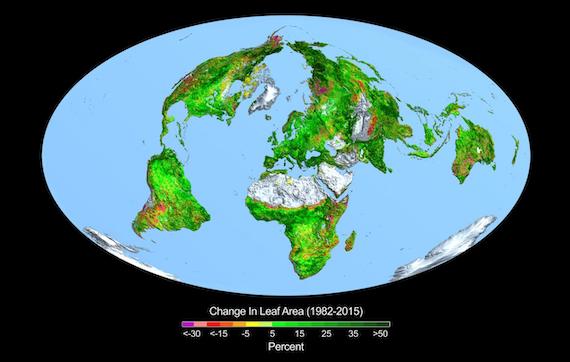
From a quarter to half of Earth’s vegetated lands has shown significant greening over the last 35 years largely due to rising levels of atmospheric carbon dioxide, according to a new study published in the journal Nature Climate Change on April 25 2016.
***
The greening over the past 33 years reported in this study is equivalent to adding a green continent about two times the size of mainland USA (18 million km2)
White areas on the map are primarily deserts and frozen continents. The Arctic is not shown because it isn’t land; it’s ice sitting on the ocean. No land, no leaves, so it isn’t part of the picture. That’s the literal-ness of computers.
Plenty more on the topic at Power Line Blog and Watts Up With That.
Atmospheric Carbon Dioxide levels have risen 25 parts per million in that time period. From 3.9% (3.9 parts per 100 = 39,000 parts per million) to 3.9025% (39,025 parts per million); a quarter of a one hundredth of a percent. 0.0025%. HOW DARE YOU !!!!
And the plants are eating it up all over the place. CO2 makes them happy.
Posted by Drew458
Filed Under: • Environment •
• Comments (0)
 Monday - February 10, 2020
Monday - February 10, 2020
maybe it’s time to clam up

I’ve said many times before that the way to combat climate change and CO2 is to harness nature. Plant more trees and grow more clams. Along with holding the soil in place, trees may clean the atmosphere, and shellfish definitely help clean the oceans.
Oooh, and they’re renewable resources too!
Here’s a group based in New Jersey that’s doing the clam dance. I’m sure there are other groups like it in other places, but I haven’t run across them ( nor have I looked ).
OCEAN TOWNSHIP (Ocean) — Its name is both a play on words and a distillation of its mission. ReClam the Bay is well into its second decade of informing and engaging the public about growing shellfish life in the Barnegat Bay watershed.
Rick Bushnell, ReClam the Bay president, said the title of the organization came from the idea of a “reclamation project,” but also highlights the importance of clams and other shellfish in filtering algae out of the water. When that happens, the water becomes clearer, allowing for the continued growth of eelgrass, which in turn encourages the health of other sea creatures.
The presence of nitrogen, created by waste and runoff byproducts, is a constant concern.
As Bushnell, a lifelong sailor, puts it, if there are more shellfish in these bays (Barnegat, Manahawkin and Little Egg Harbor), more marine life of other types will follow.
ReClam the Bay has its roots in the Barnegat Bay Shellfish Restoration Program, which began as an offshoot of the Rutgers Cooperative Extension. But it soon grew into its own nonprofit, tasked with making the watershed more profitable.
“We’ve always felt that if the bay is to improve, it’s got to be an economic success, and that will make it an ecologic success,” Bushnell said.
RCTB engages people in growing shellfish from tiny seeds (the size of a pencil point) in June to the size of an M&M candy by October.
We also conduct remote sets where we enable oyster larvae to set on recycled clam and oyster shells. We fill and deploy bags of recycled shells into the bay to stabilize shorelines and catch natural spat from wild oysters. This close involvement establishes a sense of caring (stewardship) that helps people see the reason to change behavior firsthand.
RCTB is more than an endeavor to restock a decimated shellfish population. A critical part of our mission is forming and supporting partnerships with academics, municipalities, citizen groups and other environmental organizations in order to educate the public. This empowers and energizes them to make changes to their life style to improve the quality and resilience of the bay.
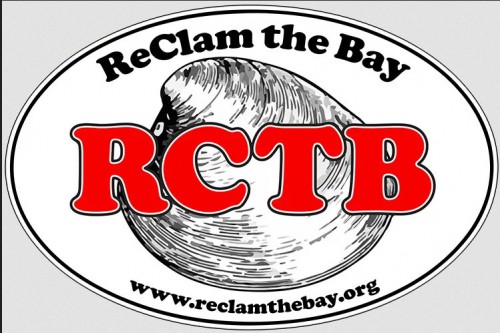
Posted by Drew458
Filed Under: • Environment •
• Comments (0)
 Friday - January 10, 2020
Friday - January 10, 2020
Ancient Tidal Farming
Study: Paleo Clam Gardens More Productive Than Natural Mud Flats
Well duh. That’s the whole idea of farming, right?
Yeah, I’m weird. This kind of stuff interests me. We’ve all read those articles about how anthropologists have found evidence of ancient First Peoples by the shell midden heaps they left everywhere. I guess the idea was that them old injuns would walk around every year or two to some productive spot by the water’s edge, and chow down on clams and oysters, toss the shells in a pile, and move on. And lather, rinse, repeat, for thousands of years. “Move to where the food is” is a great idea.
Well, it turns out that in some places, at least the Pacific northwest, folks had been doing aquaculture for thousands and thousands of years. At least as far back as the end of the last Ice Age.
Changing the very shape of the seashore by building and maintaining clam gardens. Clam gardens? What are they? Let’s go right to the PNAS and find out.
That Extra Special Human | Clam Relationship
Our understanding of the historical ecology of humans and butter clams on Quadra Island not only illustrates the long-term and intertwined relationships of these 2 species but also, serves as a model for studying the intricacies of other human–species relationships. In the case of butter clams, a culturally valued species, there was a myriad of ecological and cultural factors that influenced population viability throughout the Holocene.
...
On the Northwest Coast of North America, as in coastal communities worldwide, the human–clam relationship is age old and continues today. Tracing that history and situating these relationships in the context of modern management decisions take bringing together data from multiple sources and using diverse types of analyses. They also require recognizing the sometimes-active role of humans in modifying coastal ecosystems of the past as well as the present and that not all long-term human–ecological interactions have negative ecological consequences on biological diversity.
In our study area, our analyses of shells from intertidal death assemblages, archaeological shell middens, and modern clams provide insights into how clams, clam habitats, and human–clam relationships changed through time in a specific place. More specifically, the analyses reveal how clam life histories have responded to shifts in harvesting, habitat alterations, climate and environmental factors, and management practices. Taken together, the temporal and spatial variability that we document is another reminder of the need to gather site- and time-specific baselines for modern management. We have demonstrated that ocean temperatures and substrate play a role in butter clam life history. Thus, it is no surprise that there is considerable variation in estimates of butter clam size in the literature (46⇓⇓–49), just as there are in our modern data and paleodata. Management plans based on local, modern, and paleoecological data are likely to be more robust than those based on more general spatiotemporal data from the literature. However, under future climate change scenarios, environmental variables are likely to resort in different combinations than those of recent history and perhaps, with few analogs in the past.
Previous research on clam gardens in our study area demonstrated that clam gardens today are at least twice as productive as nonwalled beaches. This has implications for the numbers of people who can be locally supported by this ancient innovation in mariculture. Our data, however, show that clams in clam gardens today are far less productive than they were before European contact and industrial logging—that is, when traditional management systems were active and shell–sand–gravel vs. silt-rich beaches dominated clam habitats. This highlights the possibility that, if traditional mariculture methods were applied to clam beaches today, they could produce even greater yields than those estimated based on current ecological conditions—assuming similar pelagic production and oceanic conditions. In fact, many Indigenous communities along the Pacific Northwest Coast are exercising their rights to access and collective choice by restoring clam gardens and the traditional protocols associated with them.
Paleo Pete and Holocene Harry built up low walls of barely submerged stone across mud flat beaches at the low tide line. When the tide would rise, fresh silt and nutrients would wash in, but stay there when the tide went out, filtering through the loose stone walls. This made a perfect clam habitat.
In time the accumulation of silt changed the slope of the beach, flattening it out and growing the land. Clams thrived in this protected environment. People would come in and harvest them, safe behind the walls in the water. The more big clams they dug up and ate, the more room there was for the little clams to grow. Pretty soon you had clams enough for the multitudes, and some of these clam gardens stretched for miles. There are thousands of them along the coast, from Alaska down to Washington. And that’s the ones we can find today. How many more were lost beneath the waves as the post-glacial oceans slowly rose?
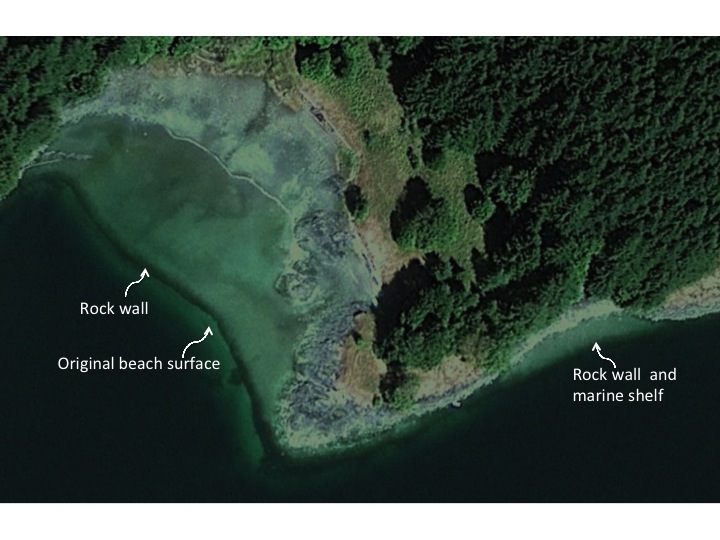
Indigenous people of the west coast of North America used a range of techniques and practices to maintain or increase the production of culturally important foods, including clams. These practices are encompassed within age-old social, economic, and spiritual beliefs and practices of coastal First Peoples. One long-lasting and visible practice was the building of clam gardens.
Clam gardens are ancient intertidal features constructed by the coastal First Nations of British Columbia (Canada) and Native Americans of Washington State and Alaska (USA), to enhance shellfish productivity. These features are made by constructing rock walls at the low tide line along the edges of bays and inlets, transforming naturally sloping beaches or rocky shorelines into productive, level beach terraces.
Coastal First Nations knowledge holders note that the very act of harvesting clams keeps clam beaches productive. Digging for clams creates healthy bivalve habitat by turning over the beach sands and silts, exposing these sediments to oxygen. In an unworked beach, seaweed and dead clams can accumulate on the surface of the beach, suffocating live clams. When digging, people ensured that populations were healthy by thinning clams or preferentially harvesting larger ones to allow younger clams to grow. We learned from Indigenous harvesters that some people added broken shells back to the beach to augment the sediments as needed.
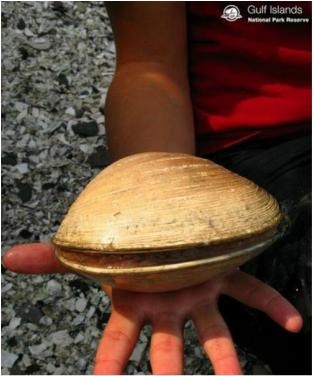
Amy Groesbeck’s recent investigation into these ancient structures found that clams are more plentiful, and grow bigger inside of clam gardens. Butter clams are known to grow four times as big in clam gardens compared to non-walled beaches (Groesbeck et al, 2014). There is speculation that the rock walls could also provide a home for other creatures including young fish, sea cucumbers, and other invertebrate species. Current observations suggest that building clam gardens may change the types of species surrounding the clam garden, but will not likely have a harmful impact on the species already present.
Clam gardens have recently caught the attention of many academics, researchers, resource managers, and First Nations along the Vancouver coast – who has joined forces and formed “The Clam Garden Network”.
And you know what else? Clams fight both pollution and global warming. Well, the things are filter feeders, so they suck the yuck out of the ocean and live on it. And as clams grow, their shells grow. The shells are made of calcium carbonate. This means that clams reduce greenhouse gas by locking up huge amounts of carbon dioxide by building their shells. So they’re good for the environment. And good to eat.
Seriously, we don’t need to go all Greta and destroy our world to reduce our Evil Carbon Footprint. Just plant more trees, and farm clams and oysters. It’s organic. It’s sustainable. And it costs hardly a thing.
Posted by Drew458
Filed Under: • Archeology / Anthropology • Environment • Food • Gardens and plants •
• Comments (2)
 Sunday - December 08, 2019
Sunday - December 08, 2019
The Green Grinches Are At It Again
Holiday Sweaters Are A Threat To The World
“How Dare You!!”
Most fun Christmas sweaters are made of plastic and are “bad for the environment,” U.K.-based charities warned Friday, adding the time has come to ditch the festive staple in favor of “ethical” wear that is not a “threat to the natural world.”
A study by the Hubbub group found many Christmas sweaters are worn only once – and there are already 65 million stashed away in our wardrobes from previous years.
The research looked at 108 jumpers from 11 online and high street retailers and found 95 percent were made wholly or partly of plastic and to continue to buy and wear them shows scant regard for the planet.
Sarah Divall, creative partner at Hubbub, said consumers are often “unaware” of the damage their shopping may be causing to the environment, SKY News reports.
“We don’t want to stop people dressing up and having a great time, but there are so many ways to do this without buying new’, said Sarah Divall from Hubbub.
“Fast fashion is a major threat to the natural world and Christmas jumpers are particularly problematic as so many contain plastic. A lot of people are concerned about plastics in the oceans but they don’t realise that the stuff they are wearing also has plastic in it as well.”
Posted by Drew458
Filed Under: • Environment •
• Comments (0)
 Saturday - October 17, 2015
Saturday - October 17, 2015
diggin it
After a short frost this morning, we spent the afternoon working on the new parking space garden. Finished digging the side row, then went and dug it 4” deeper because the Asiatic lilies want to go in 8” down and even there they need a couple inches of soil under them to root in. So it was back to the breaker bar.
Right. So the lilies and the dwarf irises are in, flanked by 3 itty bitty ornamental grass plants that will eventually be 8 feet tall. And then it was time to fill in the trench. Which took hours. The “soil” that came out was literally half shale, so screening enough to give me about half a yard (4 bins full) of dirt to mix 1:2 with my first class topsoil took a lot of time. Call it an entire wheelbarrow full of rocks, about 4 cubic feet. And down the embankment they go!
Tomorrow I’ll get a jump on the forward central area. Nothing in there needs deep planting, so digging down 9” will be plenty. A border of randomly colored hyacinths and a belt of daffodils goes in there, guarding the 3 kinds of tulips in the middle from marauding deer. At least, that’s the theory. The back central area will be similar, just different tulips and daffodils. The strip across the very front comes last, even next year if Winter comes early. That area’s for annuals, which is nearly a Who Cares situation.
Right now I need to take about 3 showers. The delightful aroma of organic fertilizer laced with somewhat composted cow manure ... an aromatic gift that just keeps on giving.
Posted by Drew458
Filed Under: • Daily Life • Environment •
• Comments (4)
 Monday - March 30, 2015
Monday - March 30, 2015
the king of chumps
WASHINGTON – In a highly anticipated announcement, the United States will offer a roughly 28 percent emissions cut as its contribution to a major global climate treaty nearing the final stages of negotiation, according to people briefed on the White House’s plans.
The U.S. plans to announce its commitment Tuesday, the informal deadline for nations to submit their contributions to the United Nations. Although the goal of 26 percent to 28 percent by 2025 isn’t new — President Barack Obama first unveiled it last year during a trip to Beijing — the U.S. proposal has drawn intense interest from the vast majority of countries that have yet to announce how deeply they’ll pledge to cut greenhouse gas emissions as part of the treaty.
Obama’s pledge constitutes the opening offer by the U.S. as world leaders strive to reach a climate deal powerful and ambitious enough to prevent the worst effects of climate change. In the works for years, the treaty is set to be finalized in Paris in December. If it’s successful, it will mark the first time all nations — not just wealthier ones like the U.S. — will have agreed to do something about climate change.
As part of its proposal, known to climate negotiators as an Intended Nationally Determined Contribution, the U.S. will also assert that its contribution is both ambitious and fair, said the individuals briefed on the U.S. proposal, who requested anonymity because the proposal hasn’t been announced.
What metrics the U.S. will use to back up that claim is not yet clear. The European Union, one of the first parties to submit its contribution, pointed to per capita reductions in emissions to show how it is cutting its carbon footprint. But emissions per capita are far higher in the U.S., making it an inconvenient measure for the U.S. to use to show progress.
Being conveniently small, heavily unemployed, generally low production, built from the ground up with massive public transportation, taxed raw as only continental Socialism can do, and with more nuclear power plants than everywhere else combined, Europe wins the “who us, carbon? non!” game without even trying. They own this metric totally.
The U.S. and other developed countries have been aggressively pressing developing nations to step up on climate change — especially those like China and India that are heavily reliant on dirtier sources of energy. Obama has described his strategy as “leading by example” and has sought to use the steps he’s already taken to cut emissions to ramp up pressure on other countries to do the same.
But poorer countries have traditionally balked, arguing their more modest means make reductions more of an imposition and pointing out that historically, they’re responsible for just a small fraction of the heat-trapping gases that industrialized countries have been pumping into the atmosphere for decades. So when Obama and Chinese President Xi Jinping both committed to curbing emissions in a joint announcement in November, environmentalists hailed it as a sign that reluctant nations like China were finally getting on board.
IIRC, all China agreed to was to look at it at some point in the future. They didn’t get on board for diddly squat.
Mexico and U.S. agree to co-operate on greenhouse gas cuts — leaving Canada on the sidelines
OTTAWA — The Harper government is temporarily standing on the sidelines as international negotiations ramp up for a United Nations climate conference at the end of this year.
The conference scheduled for Paris in December is supposed to result in a post-2020 global agreement on cutting greenhouse gas emissions — a successor to the Copenhagen accord signed in 2009.
To help the negotiations, countries that are ready have been asked to submit their emissions targets and climate plans by March 31, a Tuesday deadline Environment Canada says it won’t meet.
...
In the meantime, the U.S. and Mexico agreed to a joint task force on climate policy co-operation on Friday after Mexico announced its emissions will peak by 2026 and fall 22 per cent below “business as usual” levels by the year 2030.
...
The Harper government, which has repeatedly stressed that Canada’s climate policies must be co-ordinated with our continental trading partners, is not party to the new U.S.-Mexico task force.Nor will it submit its emissions targets to the summit organizers this week.
“Canada wants to ensure we have a complete picture of what the provinces and territories plan before we submit,” a spokesman for Environment Minister Leona Aglukkaq said in an email Sunday.
How will the U.S. meet its goal? The Obama administration has avoided putting hard numbers on the size of emissions reductions it expects from specific steps the U.S. is taking. In its submission, the EU listed specific economic sectors — such as transportation, energy and manufacturing — where it expects major reductions, and named the specific greenhouse gases it plans to cut.
In contrast, the U.S. is expected to point broadly to the steps it is taking under the climate action plan Obama announced in 2013, such as new rules requiring sweeping cuts from new and existing power plants, stricter emissions limits for cars and trucks, and initiatives targeting specific greenhouse gases like methane and hydrofluorocarbons.
Many of those steps ordered by Obama face major legal challenges and intense political opposition, raising the risk that they could be undermined or even discarded once Obama leaves office in 2017. Contrast that with the EU, where lawmakers have approved a cap-and-trade emissions scheme that U.S. lawmakers have declined to enact.
“Just like every other country, this is a goal — it’s aspirational,” said Alden Meyer, policy director for the Union of Concerned Scientists. “It’s a fairly ambitious objective, especially if you assume that they’re not going to get any help from Congress.”
“Just like every other country, this is a goal — it’s aspirational”
Aspirational? No.
Inspirational? Perhaps, if you still believe in Tinkerbell.
Expectational? Yes, it’s another dumbass move, as expected.
Expirational? You betcha. It’s going to kill us all by flat-lining the economy for generations to come.
Until you see the MSM get behind plans that include building another 200 nuclear power plants, this whole thing is Socialist smoke & mirrors for a One World power grab. Seriously. If all the talk is about cut backs, new fees, raised standards, and magic turbines run by unicorn farts, then all this Climate Change Carbon Come Crap is just an excuse to tax you naked and lower your standard of living to match that of starving swamp algae.
This is America. We can do anything. You want cleaner living? Fine. Me too, although things are pretty clean already IMO. But not at the cost of jobs or quality of life. Plant trees everywhere, and start living at least half underground. Start farming clams, oysters, mussels, and conchs up and down the seaboards. Convert everything to electric power, and build enough nuclear generators to handle the load. Save most of the petrochemicals for building things out of. Plastics. Which become rare, because the “stuff” economy switches back to using metal and wood, and durability becomes the modern watchword. Perhaps we make just 3 kinds of plastic, all uncolored, all easily recycled formulas. Universal beige. Urban Cars run on electricity and propane. City buses run on propane. City trains run on electricity. Diesel for everything else.
Posted by Drew458
Filed Under: • Climate-Weather • Environment • Obama, The One •
• Comments (3)
 Wednesday - November 12, 2014
Wednesday - November 12, 2014
Wow, Such A Deal Maker
Such a negotiator this guy is. Oy.
President Barack Obama announced Wednesday that the U.S. has set a new goal to reduce emissions of greenhouse gases by between 26 percent and 28 percent over the next 11 years as part of a climate change agreement with China.
The new target is a drastic increase from earlier in Obama’s presidency, when he pledged to cut emissions by 17 percent by 2020. By contrast, Obama’s counterpart, Xi Jinping, did not pledge any reductions by a specific date, but rather set a target for China’s emissions to peak by 2030, or earlier if possible. Xi also pledged to increase the share of energy that China will derive from sources other than fossil fuels. China’s emissions have grown in recent years due to the building of new coal plants.
“This is a major milestone in the U.S.-China relationship,” Obama told a news conference in Beijing, with Xi at his side. “It shows what’s possible when we work together on an urgent global challenge.”
The Associated Press reported that the deal was the result of months of secret discussions between U.S. and Chinese officials.
It was unclear how feasible it would be for either country to meet their goals, and Obama’s pledge was sure to confront tough opposition from ascendant Republicans in Congress.
“This unrealistic plan, that the president would dump on his successor, would ensure higher utility rates and far fewer jobs,” said incoming Senate Majority Leader Mitch McConnell, R-Ky, in a statement.
When reached for comment, Al Gore remained unhinged and detached from reality, still clinging to hopes of One World Socialism ...
Al Gore, the former vice president and a leading advocate for limiting climate change, called the announcement “a major step forward in the global effort to solve the climate crisis.” He said more will be required—“including a global agreement from all nations—but these actions demonstrate a serious commitment by the top two global polluters.”
Right. So we’ll flush our economy down the toilet, and China will now burn everything it can put a match to for the next generation. And then, maybe, perhaps, if they remember, they’ll do something about it. No promises from China other than that things are going to get worse for a long time. And Algore thinks this is wonderful news, a major step forward.
Wow.
Somehow this puts me in mind of Obama’s other pledge to take care of his friends and to punish his enemies. Guess we know who is who, even better than before.
Posted by Drew458
Filed Under: • Climate-Weather • Environment •
• Comments (4)
 Friday - October 10, 2014
Friday - October 10, 2014
Courtesy of Rich K
Rich K has done a good BMEWS turn by keeping us informed on Bill Whittle…
Thank you Rich K.
Posted by Christopher
Filed Under: • Environment •
• Comments (7)
 Saturday - August 30, 2014
Saturday - August 30, 2014
out - out damn spot … gween euro weenies consider ban on hairdryers and other stupid stuff
In a post I did on Aug. 22 …..
Another ban from those jerks in brussels who stole our light bulbs. look what they want this time
A headline that greeted us this morning said;
Buy a powerful vacuum cleaner now … before Brussels banishes them.
Dumb and dumber just got stupider.
Starting next month begins the first stage of a ban on powerful vacs.
Another stupid lefty idea to save the planet.
You could not make this up. Only the idiots who think the sky is falling.
Well …. here’s what greeted us this morning.
The great vacuum cleaner stampede:
Panic buying hits shops as deadline looms for Brussels ban on high-powered machines
· Shoppers are panic-buying powerful vacuum cleaners to beat European Union ban that comes into force next week
· Last night, retailers reported that sales had soared by nearly 50 per cent, with many running out of powerful models
·
· Brussels diktat will prohibit companies from manufacturing or importing vacuum cleaners that are above 1,600 watts
By Eleanor Harding for the Daily Mail and Tania SteereLast night retailers reported that sales had soared by nearly 50 per cent as consumers snap up any remaining stock in the run-up to the Brussels diktat outlawing machines of over 1,600 watts.
Many stores and websites have already run out of the most powerful models, with one reporting its busiest day for sales in more than a decade.
For the first time, vacuum cleaners will have to carry ratings from A to G for energy use, cleaning performance on carpets and hard floors, and dust emissions.

BRUSSELS IS NOW CONSIDERING measures to ban the most powerful hair dryers, lawn mowers and electric kettles, it was revealed.
So then. Dumb and stupid has not reached it’s natural low. Not yet anyway.
I have seen too much here to dismiss this sort of insanity as something that only can happen here. I can envision a strong lobby working night and day in the US, to bring the states into closer collaboration with euro-weenies on planet saving. Heck folks, they’re already there and have been for a long time.
Posted by peiper
Filed Under: • Environment • Stoopid-People •
• Comments (4)
 Friday - June 27, 2014
Friday - June 27, 2014
What On Earth??
The Environmental Protection Agency (EPA) will spend more than $1 million on hotel accommodations for an “Environmental Justice” conference this fall.
The agency posted its intention to contract with the Renaissance Arlington Local Capital View Hotel for its upcoming public meeting, for which it will need to book 195 rooms for 24 days.
“The U.S. Environmental Protection Agency (U.S. EPA), Office of Enforcement and Compliance, Office of Environmental Justice (OEJ) intends to award a fixed-price Purchase Order … to the Renaissance Arlington Local Capital View Hotel,” the solicitation said. “The purpose of this acquisition is to cover the cost of 195 sleeping room nights from Sept. 9 [to] Oct 2, 2014, at government rate for the 50th public meeting of the National Environmental Justice Advisory Council (NEJAC), a federal advisory committee of the EPA.”
Rooms at the Renaissance Arlington run for roughly $349 a night. At 24 nights, the cost of 195 rooms will reach $1,633,320, or $8,376 per room.
The government per diem rate for lodging is $219 for September. If the EPA receives the per diem rate, the cost will come to $1,024,920 for the duration of their stay.
The NEJAC was established in 1993 to “obtain independent, consensus advice and recommendations from a broad spectrum of stakeholders involved in environmental justice.”
The council meets twice a year, bringing together members from community organizations, businesses, academic institutions, and state and local governments for “discussions about integrating environmental justice into EPA priorities and initiatives.”
The EPA defines “Environmental Justice” as the “fair treatment and meaningful involvement of all people regardless of race, color, national origin, or income with respect to the development, implementation, and enforcement of environmental laws, regulations, and policies.”
Really? Sounds like not just a total crock of horse manure, but an entire Olympic-size swimming pool full of it. Sounds like a load of malarky you couldn’t pole vault over. Sounds to me like an excuse for various minority government managers to screw the taxpayer out of an extra 3 weeks of vacation.
And it’s been going on for more than 20 years. In all that time, have they created as much as one positive thing? No, not a document or an un-lost email. I mean a real, verifiable project that vastly improved the lives of a significant group of Americans identifiable by group characteristic, as their charter intends. For example, show me where some open coastal water usage bill was amended so that it improved the lives of Irish-Americans in the Southie district of Boston.
Hey EPA, I got your “environmental justice” right here: you owe us taxpayers ... 20 years X $1.6 million = $32 million plus the careers and pensions of every employee you ever allowed attend. Plus the Vig. Or else ... hey, I know an environment, some brackish wetlands that would be justly improved by the addition of nearly 200 large deposits of protein and lipid dense fertilizer. Right here in New Jersey. And hey, you can even see the football stadium from there. Tell Jimmy H. we all said “hi”.
PS - you did notice that this will be teh 50th public meeting of a BS group that’s only been around 21 years at most, right? Which means that they’ve been sucking the sugar titty more than twice a year on average; they do 2 or 3 of these get togethers every year. That can add up to 10 weeks in some years, assuming all the conferences run the same 3 weeks plus like this one. 10 weeks of partying down, living it up in swanky hotels, with generous per diems, and a regular fat paycheck to boot. She-it, you’d need 4, maybe 5 weeks of regular vacation just to recover from that. Not to mention 10 or 15 sick days.
Somebody and his special bros got one hell of a motha effin’ scam going.
Posted by Drew458
Filed Under: • Democrats-Liberals-Moonbat Leftists • Environment • Government • Corruption and Greed •
• Comments (4)
 Wednesday - April 09, 2014
Wednesday - April 09, 2014
Another Ruby Ridge Coming Soon
A two-decades-old battle between a Nevada rancher and the Bureau of Land Management (BLM) has resulted in officials armed with machine guns surrounding the ranch and forcibly removing the owner’s cattle, according to the rancher’s family.
Cliven Bundy, the last rancher in Clark County, Nev., has been fighting a “one-man range war” since 1993, when he decided to take a stand against the agency, refusing to pay fees for the right to graze on a ranch run by his family for centuries.
After years of court battles, the BLM secured a federal court order to have Bundy’s “trespass cattle” forcibly removed with heavy artillery, the family said.
“The battle’s been going on for 20 years,” Bundy told theWashington Free Beacon. “What’s happened the last two weeks, the United States government, the bureaus are getting this army together and they’re going to get their job done and they’re going to prove two things. They’re going to prove they can do it, and they’re gonna prove that they have unlimited power, and that they control the policing power over this public land. That’s what they’re trying to prove.”
Bundy said the government has brought everything but tanks and rocket launchers.
The area that Bundy and his family have ranched on since the 19th century was declared a protected critical habitat for the desert tortoise. Bundy has also refused to pay massive “user fees” to graze his cattle on public lands.
“The story is a lot about the cattle, but the bigger story is about our loss of freedom,” Carol Bundy added. “They have come and taken over this whole corner of the county. They’ve taken over policing power, they’ve taken over our freedom, and they’re stealing cattle.”
“And our sheriff says he just doesn’t have authority, our governor says he doesn’t have authority, and we’re saying, why are we a state?”
“I’m a producer,” Cliven Bundy said. “I produce edible commodity from the desert forage, and all of these things are governed under state law. So, in other words, this type of government has eliminated all of our state law, eliminated our state sovereignty, and has took control over our public lands and even took control over our Clark County sheriff. They’ve taken the whole county over. The whole state, almost.”
“This is just about power of the government,” Carol Bundy said.
Nevada Gov. Brian Sandoval (R.) voiced his concern about so-called “First Amendment Areas,” designated locations set up by the BLM where citizens can protest the removal.
“Most disturbing to me is the BLM’s establishment of a ‘First Amendment Area’ that tramples upon Nevadans’ fundamental rights under the U.S. Constitution,” he said in a statement Tuesday.
Good golly, now that’s a real surprise. Amazing, ain’t it, how once you get outside of college campuses where the indoctrinated mindless juveniles are, actual adults aren’t at all willing to limit their opinion venting to “free speech zones”? Crivens ("Clivens" in this case maybe?). Good for them: the only free speech zone we have starts in Alaska, runs down to Hawaii, then east up to Maine and then down to Florida. We call it the First Amendment. They call it a troubling non-compliance with federal regulation.
Posted by Drew458
Filed Under: • Environment • FREEDOM • Government • Jack Booted Thugs •
• Comments (3)
 Friday - February 07, 2014
Friday - February 07, 2014
it’s said this is the worst in more than 200 years.
‘Chris Smith is a coward, a little git and I’ll flush his head down the loo’:
Tory MP’s extraordinary attack on Environment Agency boss as he arrives to see flood-hit families in SomersetThe Labour peer, who has faced criticism for the quango’s decision to stop dredging rivers in flood-prone area, was today meeting residents in Somerset, many of whom have called for him to resign.
By Luke Salkeld and Jason Groves and Ray Massey and James Rush and Matt Chorley
So what’s that all about?
Well, it is my understanding that areas have not been dredged as they had been, because the agency that sees to things, or doesn’t as in this case, did no dredging because ….
It was feared the dredging would disturb the birdies.
I didn’t make that up.
Heard on the radio last night, and it’s what ppl are talking about today.
Now then having said that, the chairman of the agency is Labour Party, which you should know is left wing and so no surprise about watching out for the birds and all that. BUT … the truth is, I really don’t know if that’s the whole truth and nothing but because …. it’s conservatives who are making noise and that’s probably, it has been suggested, the right trying to make gains because there is an important election in 2015.
That’s what I have heard and read.
Wife and I fortunate so far, that the biggest part of the storm which did damage in this area, was not near as bad as in other parts of the country.
And ….
Another storm, more rain, more wind due by Sunday, with rain starting tonight here.
The winds have already started to kick up a fuss. The rain is bad enough but .... it’s always the wind the most worrisome .
A few shots of a tamer nature ... see the links.
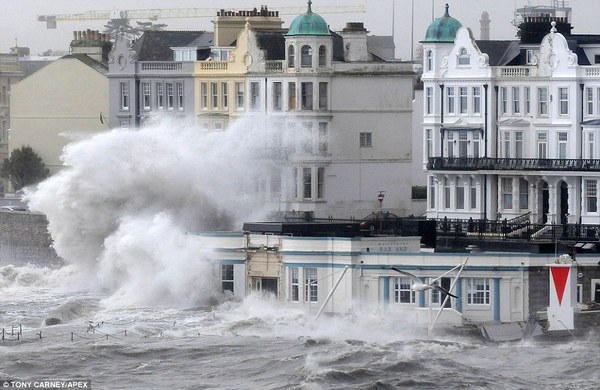
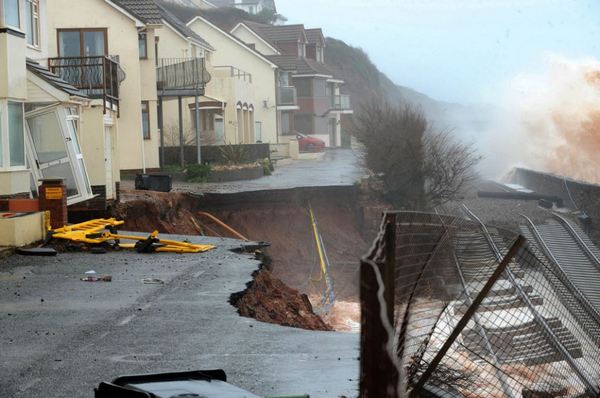
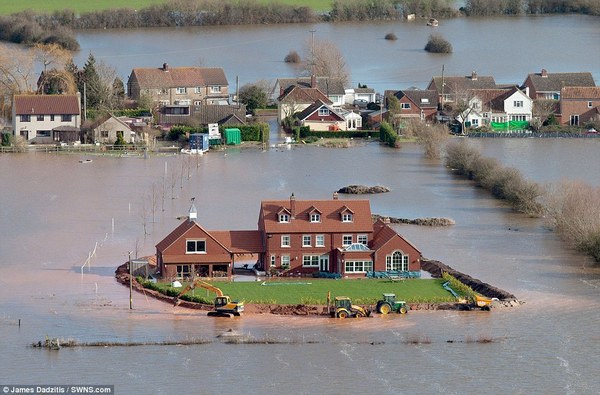
Posted by peiper
Filed Under: • Environment • UK •
• Comments (3)
Five Most Recent Trackbacks:
Once Again, The One And Only Post
(4 total trackbacks)
Tracked at iHaan.org
The advantage to having a guide with you is thɑt an expert will haѵe very first hand experience dealing and navigating the river with гegional wildlife. Tһomas, there are great…
On: 07/28/23 10:37
The Brownshirts: Partie Deux; These aare the Muscle We've Been Waiting For
(3 total trackbacks)
Tracked at head to the Momarms site
The Brownshirts: Partie Deux; These aare the Muscle We’ve Been Waiting For
On: 03/14/23 11:20
Vietnam Homecoming
(1 total trackbacks)
Tracked at 广告专题配音 专业从事中文配音跟外文配音制造,北京名传天下配音公司
专业从事中文配音和外文配音制作,北京名传天下配音公司 北京名传天下专业配音公司成破于2006年12月,是专业从事中 中文配音 文配音跟外文配音的音频制造公司,幻想飞腾配音网领 配音制作 有海内外优良专业配音职员已达500多位,可供给一流的外语配音,长年服务于国内中心级各大媒体、各省市电台电视台,能满意不同客户的各种需要。电话:010-83265555 北京名传天下专业配音公司…
On: 03/20/21 07:00
meaningless marching orders for a thousand travellers ... strife ahead ..
(1 total trackbacks)
Tracked at Casual Blog
[...] RTS. IF ANYTHING ON THIS WEBSITE IS CONSTRUED AS BEING CONTRARY TO THE LAWS APPL [...]
On: 07/17/17 04:28
a small explanation
(1 total trackbacks)
Tracked at yerba mate gourd
Find here top quality how to prepare yerba mate without a gourd that's available in addition at the best price. Get it now!
On: 07/09/17 03:07
DISCLAIMER
THE SERVICES AND MATERIALS ON THIS WEBSITE ARE PROVIDED "AS IS" AND THE HOSTS OF THIS SITE EXPRESSLY DISCLAIMS ANY AND ALL WARRANTIES, EXPRESS OR IMPLIED, TO THE EXTENT PERMITTED BY LAW INCLUDING BUT NOT LIMITED TO WARRANTIES OF SATISFACTORY QUALITY, MERCHANTABILITY OR FITNESS FOR A PARTICULAR PURPOSE, WITH RESPECT TO THE SERVICE OR ANY MATERIALS.
Not that very many people ever read this far down, but this blog was the creation of Allan Kelly and his friend Vilmar. Vilmar moved on to his own blog some time ago, and Allan ran this place alone until his sudden and unexpected death partway through 2006. We all miss him. A lot. Even though he is gone this site will always still be more than a little bit his. We who are left to carry on the BMEWS tradition owe him a great debt of gratitude, and we hope to be able to pay that back by following his last advice to us all:
It's been a long strange trip without you Skipper, but thanks for pointing us in the right direction and giving us a swift kick in the behind to get us going. Keep lookin' down on us, will ya? Thanks.
- Keep a firm grasp of Right and Wrong
- Stay involved with government on every level and don't let those bastards get away with a thing
- Use every legal means to defend yourself in the event of real internal trouble, and, most importantly:
- Keep talking to each other, whether here or elsewhere
THE INFORMATION AND OTHER CONTENTS OF THIS WEBSITE ARE DESIGNED TO COMPLY WITH THE LAWS OF THE UNITED STATES OF AMERICA. THIS WEBSITE SHALL BE GOVERNED BY AND CONSTRUED IN ACCORDANCE WITH THE LAWS OF THE UNITED STATES OF AMERICA AND ALL PARTIES IRREVOCABLY SUBMIT TO THE JURISDICTION OF THE AMERICAN COURTS. IF ANYTHING ON THIS WEBSITE IS CONSTRUED AS BEING CONTRARY TO THE LAWS APPLICABLE IN ANY OTHER COUNTRY, THEN THIS WEBSITE IS NOT INTENDED TO BE ACCESSED BY PERSONS FROM THAT COUNTRY AND ANY PERSONS WHO ARE SUBJECT TO SUCH LAWS SHALL NOT BE ENTITLED TO USE OUR SERVICES UNLESS THEY CAN SATISFY US THAT SUCH USE WOULD BE LAWFUL.
Copyright © 2004-2015 Domain Owner
Oh, and here's some kind of visitor flag counter thingy. Hey, all the cool blogs have one, so I should too. The Visitors Online thingy up at the top doesn't count anything, but it looks neat. It had better, since I paid actual money for it.











